
- Home
- Authenticity
- Material
- Origin
- Style
- 1940-1960 (159)
- Antique (72)
- Antiquity (164)
- Antiquité (301)
- Art Populaire (19)
- Directoire (32)
- Louis Philippe (69)
- Louis Xiii (39)
- Louis Xiv, Baroque (124)
- Louis Xvi (90)
- Moyen-âge (61)
- Napoleon Iii (207)
- Napoleon, Empire (29)
- Napoléon Iii (423)
- Napoléon, Empire (75)
- Ottoman (51)
- Renaissance (104)
- Restauration (32)
- 1900 (27)
- 1970 (31)
- Other (2938)
- Sub-type
- Type
Large Bottle Of Passion 19th Carved Wood Folk Art Religion
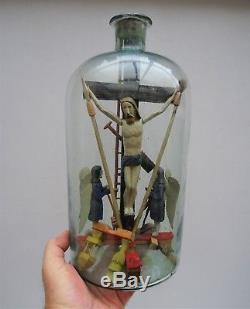
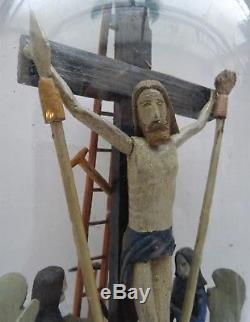
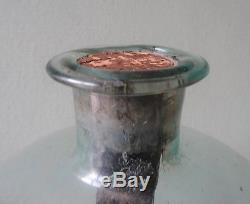
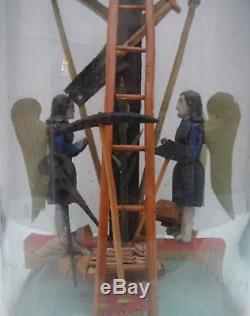
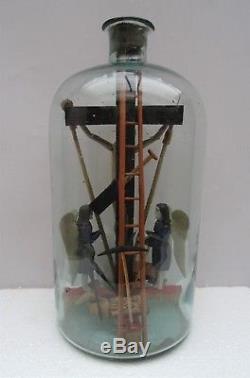
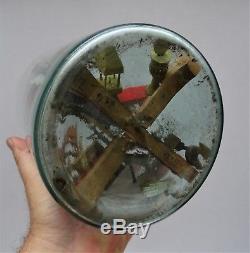
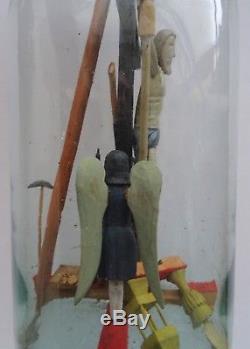
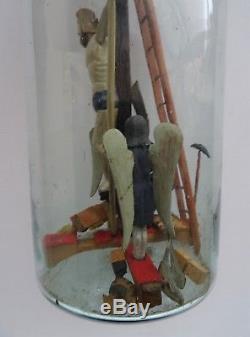
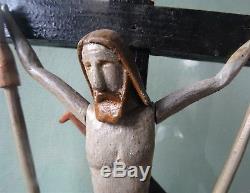
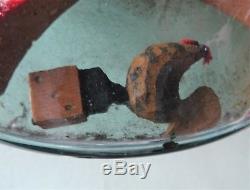
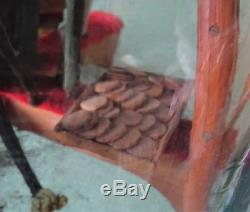
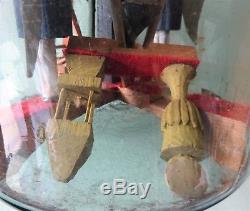


Bottle of passion work of patience found there in miniature Christ on the cross with the main instruments of passion made of wood carved with a knife and painted note that all the elements are nested (some are debited) here the Christ is surrounded by two angels with a height of 10.5 cm each! Rare popular work late 19th placed in a beautiful blown glassware with traces of impurity on the bottle and pontil in the ass. Height: 33 cm, 16,5 cm diameter to see the many photos so a beautiful size! The Christ alone measures 17 cm high ...
The opening of the neck is about 3 cm closed by its cork. We find "crosses of passion" in miniature enclosed in glass bottles, in the manner of bottled boats made by sailors: bottle of passion, or bottle-passion.
Sometimes the instruments of passion are simply suspended by wires inside the bottle, hung on protrusions in the form of bubbles. The origin of this practice, dating back to the eighteenth century, is undoubtedly to seek joy (aisne) where a miraculous fountain attracted many pilgrims. Everyone left with a bottle filled with this water.Then we made some kind of glass bulbs, in which we hung little figurines out of colored spun glass, representing two types of objects: on the one hand, the instruments of the passion, on the other hand of the characters and objects related to the legend of jubilation. These vials were then filled with miraculous water. The practice existed in Germany, in the mountains of lallgäu and lerzgebirge, where various scenes and crosses of passion were made under the term geduldsflasche ("bottle of patience"). Subsequently this fashion spread and these bottles were made everywhere, especially in Brittany where the art of bottling boats already existed then in many countries up to Quebec. (source wikipedia) bottle-passion here is an object of curious devotion that will raise at least one question: how to enter all these objects by the neck of the bottle while it seems logically impossible ???
Go, courage and patience, all you have left is to read this article and the veil will be lifted! A bottle-passion is a transparent glass bottle, whose glass can sometimes be slightly bluish or greenish and contains a representation of the Christ on the cross, known as the passion of Christ or Calvary. First a bit of history. "The year 1752 saw in vienne the realization of a religious hotel with its christ in cross, candles, vases, flowers and liturgical inscriptions. It is the first, to my knowledge, a long series of bottles called "passion" which represent, in addition to the episodes of life and death of Christ, (nativity, crucifixion, deposition of the cross) masses and marriages.The first French - and Breton - bottle represents a Calvary: the Christ surrounded by two thieves, equipped with all the attributes of passion. It bears the signature "frs bazin fecit, a st meloir, this 7 aoust, year 1763" (brothers bazin, made in Saint meloir). They are called bottle-passion, bottle of passion, bottle with passion or bottle-calvary, calvary bottled and sometimes, we find them under the name partially inaccurate dex-voto. A bottle-passion can be considered as ex-voto only when it takes place in a church and only in this case. The objects on display in the bottle are all related to the passion of Christ.
So you can see: the crucifixion cross, the nails that were used to crucify Jesus, the hammer, the pincers, the sponge with the vinegar to drink at the end of the spear, the carnations, the lily flowers, the the rod of the flagellation and the reed, the derisory scepter of jesus, king of the Jews, the dice for the tunic of Christ was played on the dice, the spear of the centurion which pierced the side of Christ, the stone sword, the lantern of the guards of the court, the scepter and the whip tied to the flogging of Jesus and the column to which he was attached for this torture, the crown of thorns, the tunic, the rooster who sang three times during the denial of stone, the ladder which is often located on the back of the cross for the dependence of the cross, the phylactery inri for "jesus of nazareth, king of the Jews\dadam, first man on earth. You can also see personal additions such as religious medals and also chromos or carved engravings representing angels or holy characters such as the Virgin at the foot of the cross or Saint John, ribbons, flowers and leaves natural and dry or artificial. The customization of such a bottle was possible but not ostensible. The objects included in the bottles are made of wood, fabric, paper or cardboard colored and / or gilded, dried plant material, sometimes iron, plaster for small figurines and exceptionally embellished with glass beads a few bottles are polychrome when others have raw materials left. The containers are mostly bottles, carafes, bottles and jugs.
You want to know how to make such a bottle? Here are the tips: the first step is to create the support that will receive the cross. This support is itself in the shape of a cross that matches the shape of the bottom of the bottle. This ensures the stability of the future building. You can imagine that all the pieces are made out of the bottle but they are assembled and fixed in the bottle.
Léchelle is totally mounted on the outside of the bottle, like the cross. The wood that composes it is chosen for its flexibility: it is mainly birch or juniper, but also of hazel. After dipping the ladder in boiling water for a moment, it can twist without breaking.By carefully holding the amounts, she was thus slipped by the neck to take place at the back of the cross. Very quickly, it returns to its original form. Monsieur aubry, who restores old bottles, believing little in this process, does differently and here is his explanation: a ladder enters the bottle is a piece being the width of the neck, or, if wider, it is mounted inside each rung nested on one of the arms, then the other arm fitted on the free ends of the rungs, all assembled by tenons and mortises. The most difficult thing was to fix Christ on the cross.
Which explains why many bottles do not contain Christ. But patience and will allow to arrive at everything! Placing the pieces in the bottle is done through long needles, punches, thin wooden picks, umbrella whales, in short everything that is long, thin and pointed and that enters the neck of a bottle. Some joints are made with tenons and mortises and this implies a great ability of the bottle factor. For many, introduced objects are either nailed or glued.You may notice it on some photos below, sometimes the wooden cap is held by a nail or a small wooden key located horizontally and which emerges on each side of the bottom of the neck. It keeps the bottle closed, preventing dust from entering, while having play to allow moisture to come out of the bottle.
The cap can inflate freely, preventing the breakage of the neck. More rarely, it is adorned with a dome, a crucifix, a bell tower, a head, a ball or other religious attribute. Are bottles typical of a region? No, not specifically, these bottles exist everywhere in France and in the world. It is found in Alsace, Auvergne, Lorraine but especially where there are patients!
"However, existed in puy before 1939, a real specialist working for a speculative purpose. He sold his bottles 22 francs each to the Clermont railwaymen on the line Clermont-le Puy. The latter sold them in their turn to the winemakers of Limagne. "Extract from the book: artisans and peasants of France, 1946, led by a. 236 Some may be assigned to sailors because they include two additional lanterns, objects essential for navigation at night and highlighted on boats.
There are such bottles in Quebec. They are very complete in the number of objects that appear in them, and can be recognized by the crow standing on the cross of the cross. A thorough study of the scenery allows to locate them but a solid knowledge. These bottles were made during long winter days and by people whose occupation or occupation left them free time: sailors, soldiers or prisoners of war.They were made for themselves, as a votive offer or to be offered to friends and family. Some bottles have the particularity of containing water. This gives them a magnifying effect, making the objects included in the bottle very visible and very detailed. In Auvergne, some are filled with alcohol: "this last wood, (the juniper) also has the property it seems to give" good taste "and a beautiful amber color to the marc, because the bottles" passions o say it are not only sought for a decorative purpose, but they are filled with alcohol, "extract from the book: artisans and peasants of France, 1946, led by a.
The item "Great Bottle of Passion 19th Wood Carved Folk Art Religion" is on sale since Friday, February 23, 2018. The seller is "lecasteel" and is located in / in borre.This item can be delivered anywhere in the world.
- type: folk art object
- subtype: religious
- origin: france
- material: glass and wood
- authenticity: original
- unit quantity: 1
- style: Napoleon, Empire

